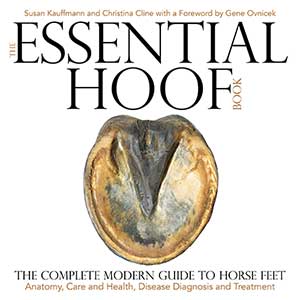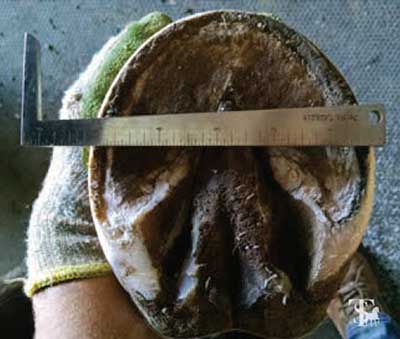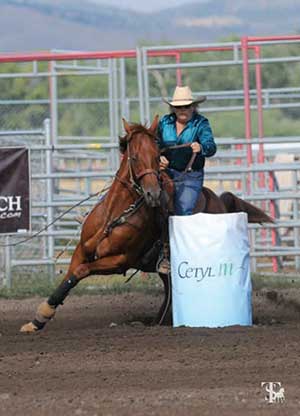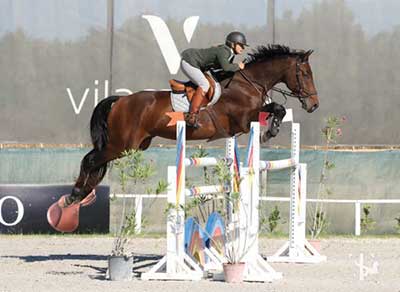
by Susan Kauffmann and Christina Cline
More and more horse owners are choosing to maintain their horses without shoes these days, for various reasons. Some are attracted by the fact that it is less expensive, others are comforted knowing they will never lose another shoe, and some feel safer with the increased surefootedness of a barefoot horse. But for most, the main reason to “go bare” is that they believe there are substantial health benefits, not just for the hooves, but for the entire horse.
Many experts agree about “going bare”…. Even Dr. Stephen O’Grady, a leading equine podiatrist who in the past was not seen as being particularly “barefoot friendly,” has actually published an article in the American Farrier’s Journal in which he states, “The equine foot with healthy structures is superior in its natural or barefoot state as opposed to the shod state with regards to accepting the weight of the horse, shock absorption and dissipating the energy of impact.”
There is still a perception among many in the horse world that barefoot only works if you don’t actually do much with your horse. Nothing could be further from the truth, as witnessed by the continually growing number of riders in disciplines ranging from endurance to eventing, from Western performance to dressage, at levels from pleasure riders to Olympic competitors, who are discovering that not only can their horses do what they do barefoot, they can do it better, and they are sounder than ever.
Those who doubt that barefoot horses can be serious performance horses should talk to British Olympian Emma Hindle, who has found that her dressage horses are not only sounder but move more correctly barefoot, in part, she believes, because they can feel the ground better. They might also want to chat with Grand Prix show jumper Sandra Gaspar Carreira, who has been so successful with her barefoot jumpers that many other international competitors—including several Olympians—are now bringing her their horses to get them on a barefoot program. Carreira says that for her, the bottom line is results, and as she sees more clear rounds and healthier feet now that her horses are barefoot, she is convinced that this is the best way for a horse to compete.

The Western sports are also seeing a rise in barefoot competitors, in part due to the success of people like two-time Women’s Professional Rodeo Association (WRPA) World Champion barrel racer Leslie Maynard, who says, “I love competing on barefoot horses—they just feel so confident on the ground.” Previously the last person to ever think barrel horses could be successful barefoot, she has found that they actually have excellent traction, even in muddy conditions, and she has been able to rehabilitate several barrel horses that were considered “lost causes,” bringing them back to success in the arena using barefoot methods.
However, if you are considering making the switch from shod to barefoot, it is important to know that the process is often more involved than simply pulling the shoes and riding off on your merry way. While it is certainly possible for many horses to make the change to barefoot, the transition is much more likely to be smooth and successful if you know what to expect, what you need to do, and how to make it all happen. You need to understand that it can take time and commitment, and you must consider the various factors that will have an effect on whether the transition goes well or not. As a starting point, it may help to ask yourself the following questions:
How healthy are my horse’s feet?
If your horse has thin soles, a damaged coffin bone, weak digital cushions, contracted heels, or other significant concerns, going barefoot is likely to take more time, effort, and knowledge than it would for a horse whose feet are relatively healthy.

Am I willing to make use of hoof boots?
Many horses, especially if they have been shod for a long time or have compromised feet, are going to need some support in the form of boots and possibly pads for a while after the shoes come off. Padded hoof boots have been shown to make a huge difference during the transition period, allowing the foot to remain comfortable while it develops and strengthens.
Is the terrain my horse lives on similar to what I want him to work on?
In general, a horse that lives on footing similar to what he is expected to work on is going to have an easier time going barefoot.

Is my hoof-care provider truly knowledgeable about barefoot trimming and hoof care?
One of the most important factors, and one that can make or break your chances at barefoot success, is how much your hoof-care provider knows about barefoot hoof care. There are specific ways to trim the hoof to maximize barefoot comfort and function, and these are often quite different from what is taught to many farriers.
This excerpt from The Essential Hoof Book by Susan Kauffmann and Christina Cline is reprinted with permission from Trafalgar Square Books (www.horseandriderbooks.com). Find this book and other on our section on BOOKS.

































